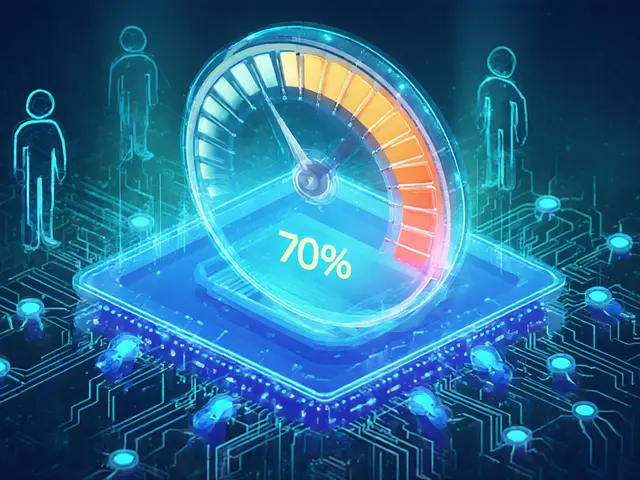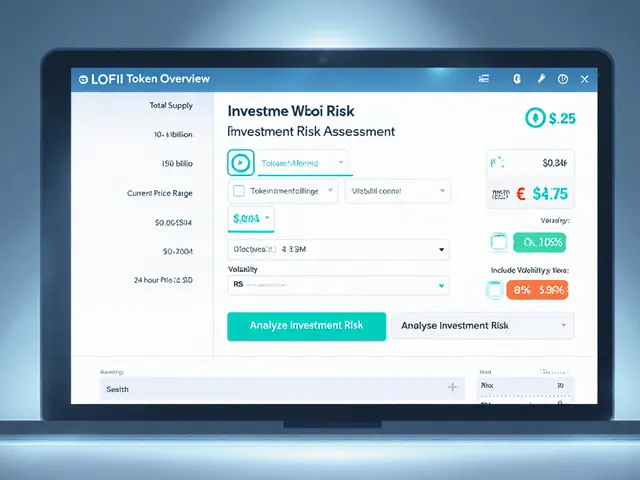IPFS CID Generator & Block Explorer
Generated CID:
Block Structure:
In IPFS, each file or piece of content is uniquely identified by a Content Identifier (CID). This CID is generated by hashing the content using a cryptographic hash function (SHA-256 by default) and then encoding the result with metadata about the hashing algorithm used.
The CID ensures data integrity: any change to the content will produce a completely different CID. This allows IPFS to verify that retrieved content matches the original.
Ever wondered how a file can live forever on the internet without a single server holding it? IPFS makes that happen by turning files into immutable fingerprints and letting any computer on the network serve them. Below you’ll see exactly what’s happening under the hood, why it matters, and how you can start using it today.
- IPFS stores files by what they are, not where they live.
- Each piece gets a cryptographic Content Identifier (CID) that guarantees integrity.
- Nodes use a Distributed Hash Table to locate the right pieces.
- Retrieval works like a global BitTorrent swarm, but with a single unified namespace.
- Getting started only requires a client or a public gateway.
What is IPFS?
IPFS (InterPlanetary File System) is a peer-to-peer protocol that creates a decentralized file system spanning every computer that runs the software. It replaces the classic “server‑client” model with a network where each participant can store and serve data. Think of it as a massive, global folder that anyone can read or write to, provided they have the right cryptographic address.
The Building Blocks: Content Addressing, CID, and the Distributed Hash Table (DHT)
Traditional URLs point to a location (a server, a path). IPFS flips that idea: it points to the content itself. When you add a file, the system breaks it into blocks, runs a cryptographic hash (SHA‑256 by default) on each block, and stitches the hashes together into a single string called a Content Identifier (CID). The CID looks like QmXoypizjW3WknFiJnKLwHCnL72vedxjQkDDP1mXWo6uco and encodes both the hash algorithm and the hash value.
The Distributed Hash Table (DHT) is the routing layer. Every node maintains a tiny slice of the entire hash space, so when you ask for a CID, the request hops from node to node until it finds someone who stores the matching block. This lookup is fast, fault‑tolerant, and completely independent of any central directory.
How a File Gets Into IPFS
- Install the IPFS client (or use a web‑based uploader).
- Run
ipfs add <myfile>. The client:- Splits the file into 256KB blocks.
- Computes a SHA‑256 hash for each block.
- Creates a Merkle‑DAG where each node points to its child block hashes.
- Generates a root CID that represents the whole file.
- The client stores the blocks locally and announces the new CIDs to the DHT.
- Other peers can now discover those blocks and start caching them.
Because the CID is derived from the content, any identical file added by anyone else produces the *same* CID. IPFS automatically de‑duplicates, so the network never stores duplicate data.
Retrieving Data: From CID to Bits
When you want a file, you type ipfs get <CID> or visit an HTTP gateway like https://ipfs.io/ipfs/<CID>. The steps are:
- The local node queries the DHT for the CID.
- The DHT returns a list of peer addresses that hold the requested blocks.
- The node opens parallel connections to several peers, downloading blocks concurrently (much like BitTorrent swarms).
- Each block’s hash is verified on‑fly; any mismatch is discarded.
- Blocks are reassembled following the Merkle‑DAG, producing the original file.
If a peer goes offline, the DHT simply redirects the request to another holder, ensuring high availability.

Why IPFS Beats Traditional URL‑Based Storage
| Aspect | IPFS | HTTP (central server) | BitTorrent |
|---|---|---|---|
| Addressing | Content‑addressed (CID) | Location‑addressed (URL) | Content‑addressed (info‑hash) |
| Data integrity | Verified by cryptographic hash | Depends on server trust | Verified by hash |
| Censorship resistance | High - any node can serve | Low - single point of control | Medium - swarm can be blocked |
| Deduplication | Automatic (same CID stored once) | None | None |
| Scalability | Linear with peers, no central bottleneck | Limited by server bandwidth | Scales with peer count |
In short, IPFS gives you permanent, verifiable links that stay alive as long as *any* node holds the data. No more “link rot” and no need to trust a single host.
Real‑World Scenarios Where IPFS Shines
Developers are already using IPFS for:
- Hosting static websites that survive outages (e.g., decentralized blogs).
- Storing NFT metadata that must never change.
- Distributing large datasets for scientific research without paying for cloud egress.
- Building censorship‑resistant portals - the decentralized Wikipedia mirror accessed via a CID is a prime example.
Because the Web3 stack relies on immutable content, IPFS acts as the go‑to storage layer for many blockchain projects.
Getting Started: From Zero to First CID
- Install the client: download the official binary from
ipfs.ioor use a package manager (brew install ipfson macOS). - Initialize your node: run
ipfs init. This creates a local repository and a peer identity. - Add a file:
ipfs add hello.txt. The output shows the CID.added QmX... hello.txt
- Access it globally: open
https://ipfs.io/ipfs/QmX...in any browser, or share the CID with friends. - Use a public gateway if you don’t want to run a node yourself. Gateways act as bridges between HTTP and the IPFS network.
Remember, every time you retrieve the CID, you’re pulling data from the nearest peers, not a distant server. Your own node also becomes a mini‑cache, helping the network stay healthy.
Common Pitfalls and How to Avoid Them
- Assuming permanence: IPFS doesn’t “store forever” by itself. If no node pins the content, it may be garbage‑collected. Use
ipfs pin add <CID>on a trusted node or a pinning service. - Large files: Very big binaries should be chunked manually or stored with a tool like IPFS Cluster to manage replication.
- Privacy concerns: Anything added is public by default. For private data, encrypt before adding or use a private IPFS network.
Frequently Asked Questions
What does a CID look like and why is it unique?
A CID encodes the hash algorithm, the hash length, and the actual hash of the content. Because the hash changes with any bit‑flip, two different files can never share the same CID, guaranteeing uniqueness.
Do I need to run a full node to use IPFS?
No. You can retrieve any CID through public gateways, which act as HTTP front‑ends to the network. Running a node gives you control and helps the ecosystem, but it’s optional.
How does IPFS ensure data isn’t tampered with?
Each block is verified against its cryptographic hash when downloaded. If a block’s hash doesn’t match the CID, the client discards it and asks another peer.
Can IPFS replace traditional cloud storage for large enterprises?
It can complement cloud storage, especially for static assets, backups, or content that needs censorship resistance. Enterprises usually combine IPFS with pinning services and access‑control layers to meet compliance and SLA requirements.
What’s the difference between IPFS and BitTorrent?
Both use peer‑to‑peer block exchange, but IPFS provides a single, global namespace (the CID) and integrates with Web3 tools, while BitTorrent works with separate swarms per torrent and relies on .torrent files for metadata.







Jan B.
July 5, 2025 AT 02:50Great overview, thanks for sharing.
MARLIN RIVERA
July 7, 2025 AT 10:23The article glosses over the real limitations of IPFS, ignoring bandwidth costs and the need for pinning services, which makes it misleading.
Debby Haime
July 9, 2025 AT 17:57Loving the clear breakdown! It's amazing how IPFS can turn any file into a permanent fingerprint, and the step‑by‑step guide makes it feel totally approachable for newbies.
emmanuel omari
July 12, 2025 AT 01:30Anyone still thinks IPFS is just a fad? The protocol relies on a DHT that is inherently vulnerable to Sybil attacks, and without proper incentives nodes will drop data, so it's not a silver bullet.
Andy Cox
July 14, 2025 AT 09:03Cool stuff, but remember you still need to pin content or it'll disappear after garbage collection.
Courtney Winq-Microblading
July 16, 2025 AT 16:37IPFS's content‑addressed model is philosophically elegant – the identity of data becomes immutable, freeing us from the tyranny of mutable URLs.
katie littlewood
July 19, 2025 AT 00:10Wow, this deep dive really opened my eyes to the inner workings of IPFS. The way it splits files into 256KB blocks is reminiscent of classic BitTorrent practices, yet it adds a layer of cryptographic security that most P2P systems lack. I particularly appreciate the explanation of Merkle‑DAGs; they make the whole structure feel both robust and elegant. The discussion about CIDs being content‑addressed rather than location‑addressed highlights a fundamental shift in how we think about the web. It's fascinating how the DHT enables decentralized routing without any central authority. The example of using public gateways shows how you can bridge the gap between traditional browsers and the IPFS network. I also like the note about deduplication – saving bandwidth and storage is always a win. Of course, the warning about the need for pinning services is crucial; otherwise, your data might vanish. Overall, a solid guide for both developers and curious tech enthusiasts alike.
Jenae Lawler
July 21, 2025 AT 07:43While the exposition is thorough, one must not overlook the geopolitical ramifications of a truly decentralized web. In particular, content moderation becomes a Herculean task.
Chad Fraser
July 23, 2025 AT 15:17Sounds solid, let's try it out.
Jayne McCann
July 25, 2025 AT 22:50I doubt this will ever replace HTTP.
Richard Herman
July 28, 2025 AT 06:23The DHT approach is clever, though it can add latency in low‑node regions.
Stefano Benny
July 30, 2025 AT 13:57From a decentralization standpoint, the Merkle‑DAG and multihash schema provide cryptographic provenance, yet the content routing layer still suffers from churn‑induced latency.
Bobby Ferew
August 1, 2025 AT 21:30I wish more people would realize how fragile this system feels when nodes vanish.
celester Johnson
August 4, 2025 AT 05:03One could argue that the very ephemerality of unpinned data mirrors existential impermanence.
Prince Chaudhary
August 6, 2025 AT 12:37Good point about pinning; using a service like Pinata can ensure persistence.
John Kinh
August 8, 2025 AT 20:10Meh, looks like another buzzword project to me.
Mark Camden
August 11, 2025 AT 03:43We must consider the ethical implications of decentralized storage, especially regarding illicit content distribution.
Evie View
August 13, 2025 AT 11:17If you think IPFS magically solves censorship, you’re naive.
Kate Roberge
August 15, 2025 AT 18:50Honestly, this looks like over‑engineered hype.
Oreoluwa Towoju
August 18, 2025 AT 02:23Pinning is essential for durability.
Jason Brittin
August 20, 2025 AT 09:57Oh great, another system that pretends to be permanent while relying on volunteers.
Carl Robertson
August 22, 2025 AT 17:30Wow, this is the most revolutionary thing since the internet itself, right?
Nathan Blades
August 25, 2025 AT 01:03IPFS represents a paradigm shift in how we think about data storage, moving from location‑based addressing to content‑based addressing.
By using cryptographic hashes as identifiers, the system guarantees that the data you retrieve is exactly the data that was originally added.
This eliminates the need for trust in a central server and dramatically reduces the attack surface for tampering.
Moreover, the distributed hash table enables efficient peer discovery without a single point of failure.
When you add a file, it is split into 256 KB blocks, each hashed and linked in a Merkle‑DAG, which provides both integrity verification and deduplication.
Because identical content yields the same CID, the network naturally avoids storing duplicate copies, saving bandwidth and storage.
Retrieval works similarly to a BitTorrent swarm: multiple peers supply blocks in parallel, which speeds up downloads and improves resilience.
If one peer goes offline, the DHT simply routes the request to another holder, ensuring high availability.
Public gateways bridge the gap for users who do not run a node, translating HTTP requests into IPFS queries.
However, permanence is not guaranteed unless the data is explicitly pinned on one or more nodes.
Pinning services, such as Pinata or Infura, act as custodians, keeping the data alive even when the original uploader disappears.
From a developer perspective, the IPFS HTTP API is straightforward, allowing easy integration into web applications.
In the context of Web3, IPFS provides the immutable storage layer that complements blockchain’s immutable ledger.
Nevertheless, challenges remain, including latency in sparse networks, incentive mechanisms for storage, and legal considerations for hosted content.
Future upgrades like Filecoin aim to address some of these issues by introducing a market for storage contracts.
Overall, IPFS offers a compelling foundation for a more decentralized internet, but widespread adoption will depend on solving the economic and governance hurdles that currently limit its scalability.
Somesh Nikam
August 27, 2025 AT 08:37Pinning strategies are indeed the key to making IPFS truly permanent, and using a reputable service can give you peace of mind.
Parker Dixon
August 29, 2025 AT 16:10If you need a quick start, try the IPFS Companion browser extension; it handles pinning locally and lets you explore CIDs without leaving the page.